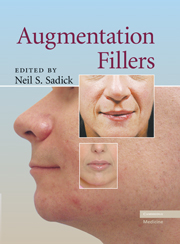Book contents
- Frontmatter
- Contents
- LIST OF CONTRIBUTORS
- Ch. 1 Application of Fillers
- Ch. 2 Approach to Choosing the Ideal Filler
- Ch. 3 Patient Selection, Counseling, and Informed Consent
- Ch. 4 Hyaluronic Acid Skin Derivatives
- Ch. 5 Collagen Products
- Ch. 6 Radiesse
- Ch. 7 ArteFill
- Ch. 8 Augmentation Fillers in Cosmetic Dermatology: Silicone
- Ch. 9 Advanta Expanded Polytetrafluoroethylene Implants
- Ch. 10 Sculptra
- Ch. 11 Lipo Transfer
- Ch. 12 BioAlcamid®
- Ch. 13 Combination of Approaches in Augmentation Fillers in Cosmetic Dermatology
- Ch. 14 Filling Complications
- Ch. 15 Postprocedure Management and Patient Instructions
- Ch. 16 Conclusion: Future Trends in Fillers
- INDEX
- References
Ch. 2 - Approach to Choosing the Ideal Filler
Published online by Cambridge University Press: 26 February 2010
- Frontmatter
- Contents
- LIST OF CONTRIBUTORS
- Ch. 1 Application of Fillers
- Ch. 2 Approach to Choosing the Ideal Filler
- Ch. 3 Patient Selection, Counseling, and Informed Consent
- Ch. 4 Hyaluronic Acid Skin Derivatives
- Ch. 5 Collagen Products
- Ch. 6 Radiesse
- Ch. 7 ArteFill
- Ch. 8 Augmentation Fillers in Cosmetic Dermatology: Silicone
- Ch. 9 Advanta Expanded Polytetrafluoroethylene Implants
- Ch. 10 Sculptra
- Ch. 11 Lipo Transfer
- Ch. 12 BioAlcamid®
- Ch. 13 Combination of Approaches in Augmentation Fillers in Cosmetic Dermatology
- Ch. 14 Filling Complications
- Ch. 15 Postprocedure Management and Patient Instructions
- Ch. 16 Conclusion: Future Trends in Fillers
- INDEX
- References
Summary
INTRODUCTION
Presently, there is no one ideal filler for all patients, for all indications, and in all situations. It is unlikely that this will ever occur, given the extreme variables in patients and in the goals of aesthetic filler injections. The type of product best for lip injection may not be the best for volumetric cheek filling or for dorsal hand augmentation. The injectable filler best for a young woman with fine skin texture is different than that for an older man with redundant folds or for acne scars. The cost of material, duration of effect, and the social downtime issue all play a role in making the final decision of product choice.
In the end, it is the technical skill of the physician and the familiarity with the product that are the most important factors in the clinical result. This discussion will review the key issues to help the practicing aesthetic physician choose the ideal FDA (Federal Drug Association) approved filler for each patient. Fillers that have not been FDA approved in the United States, autologous fat (an excellent global restorative filler), and silicone (an excellent permanent filler for HIV lipotrophy) will not be discussed here.
CHARACTERISTICS OF THE IDEAL FILLER
The ideal filler is nonallergenic, durable yet reversible, has a natural look and feel after injection, is able to be injected in off-face areas, and is very safe. It should be easy to inject and should cause only little pain, swelling, or bruising.
- Type
- Chapter
- Information
- Augmentation Fillers , pp. 5 - 12Publisher: Cambridge University PressPrint publication year: 2010
References
- 1
- Cited by

